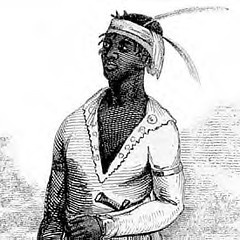
John Horse, a Black Seminole warrior who led hundreds in an escape from American bondage in 1837, re-ignited resistance to US Imperialism in 19th century Florida.
Originally uploaded by Pan-African News Wire File Photos
Written by William Loren Katz
Monday, 17 December 2007
By William Loren Katz
This Christmas Eve, the freedom-loving Bush administration had a chance to mark the anniversary of a great victory for formerly oppressed people on U.S. soil. The President is unlikely, however, to notice or heed the meaning of this particular milestone, whose cast of characters and historical lessons he would undoubtedly regard as all wrong.
December 24th, 1837 marks the 170th anniversary of the U.S. government's first significant military defeat in its first foreign incursion. The place was Florida, then a Spanish colony. The foe was a united force of Africans, on the run from the south's slave plantations, and Seminoles, whose self-determination was endangered.
The runaway Africans had been establishing prosperous, self-governing communities in the peninsula since 1738. During the American Revolution they merged with Seminole Indians into a multicultural nation that cultivated crops according to techniques learned in Senegambia and Sierra Leone. Out of this came an alliance that shaped effective diplomatic and military responses to invaders and slave catchers.
By the early 19th century, U.S. slaveholding classes saw these groups as a clear and present threat to their system of wealth production through chattel slavery. Hoping to plug the leak, they began invading Florida during the administration of President James Madison, father of the U.S. Constitution and Virginia slaveholder.
Then in 1811, Madison authorized covert U.S. military operations to assist the posses, and in 1816 General Andrew Jackson invaded, seeking annexation. A leader in that invasion, Army Lt. Colonel Duncan Clinch, reported: "The American negroes had principally settled along the Appalachicola River and a number of them had left their fields and gone over to the Seminoles on hearing of our approach. Their corn fields extended nearly fifty miles up the river and their numbers were daily increasing."
Spain, whose claim to Florida rested on a visit by Ponce De Leon and imperial hubris, gave in to U.S. persuasion and agreed to sell the colony. But this led to a protracted U.S. occupation known as the “Three Seminoles Wars." In 1837, the well-informed Major General Sidney Thomas Jesup found that Africans had become resistance leaders.
He stated: "Throughout my operations I have found the negroes the most active and determined warriors; and during conferences with the Indian chiefs I ascertained they exercised an almost controlling influence over them."
Citing the dangers presented by the two peoples from different continents having forged a single nation, he said, "The two races, the negro and the Indian, are rapidly approximating; they are identical in interests and feelings . . . . Should the Indians remain in this territory the negroes among them will form a rallying point for runaway negroes from the adjacent states; and if they remove, the fastness of the country will be immediately occupied by negroes."
Although U.S. forces destroyed crops, cattle and horses, violated agreements, and seized women and children as hostages, the multicultural Seminoles, as they protected their families and homes, ran circles around the technologically and numerically superior invaders. U.S. tactics aimed at racially dividing the Africans and Seminoles also failed. "The negroes rule the Indians,” Jesup observed, and to seek peace, “it is important that they should feel themselves secure." But peace lay two decades in the future.
The day before Christmas in 1837, U.S. Colonel Zachary Taylor marched 1,000 troops in pursuit of about 400 Seminoles. Commander Wild Cat and his sub-chief, the African Seminole known as John Horse, positioned their black and red marksmen in trees and tall grass in the northeast corner of Florida's Lake Okeechobee. As Taylor's 180 Missouri riflemen, 800 soldiers from the U.S. Sixth, Fourth, and First Infantry Regiments and 70 Delaware scouts approached, the wary Delawares hesitated, then fled. Next, the Missourians broke and ran. Taylor then ordered his regular Army forward, reporting later that pinpoint Seminole rifle fire had brought down "every officer, with one exception, as well as most of the non-commissioned officers" and left "but four . . . untouched."
On Christmas morning Taylor found the Seminoles had fled in canoes. He counted 26 U.S. dead and 112 wounded, found less than half a dozen slain Seminoles and took no prisoners. This Second Seminole War alone (1835-1842) would involve U.S. Naval and Marine units, at times half of the Army, cost 1500 military deaths and taxpayers $30,000,000.
Once his decimated army limped back to Fort Gardner, Zachary Taylor won promotion by claiming, "the Indians were driven in every direction." Later, his self-promotion as an "Indian fighter," won Taylor election as the 12th President of the United States.
Lake Okeechobee was the Army's worst defeat in Florida. But the truth of that battle and the war remain buried or distorted. For example, Arthur M. Schlesinger, Jr. in The Almanac of American History, wrote: "Fighting in the Second Seminole War, General Zachary Taylor defeats a group of Seminoles at Okeechobee Swamp, Florida." Well, not exactly.
The Seminoles' sustained and heroic resistance to the new American Republic's first foreign invasion created one of liberty's proudest moments. Those who cherish freedom-fighters should know their story. And how about those in power who have a penchant for waging "preemptive" wars?
____________________________________________________
Copyright William Loren Katz. He is the author of BLACK INDIANS: A HIDDEN HERITAGE [Atheneum Publishers] from which this article is adapted. His website is: http://www.williamlkatz.com
------------------------------------------------------------------------------------------
No comments:
Post a Comment